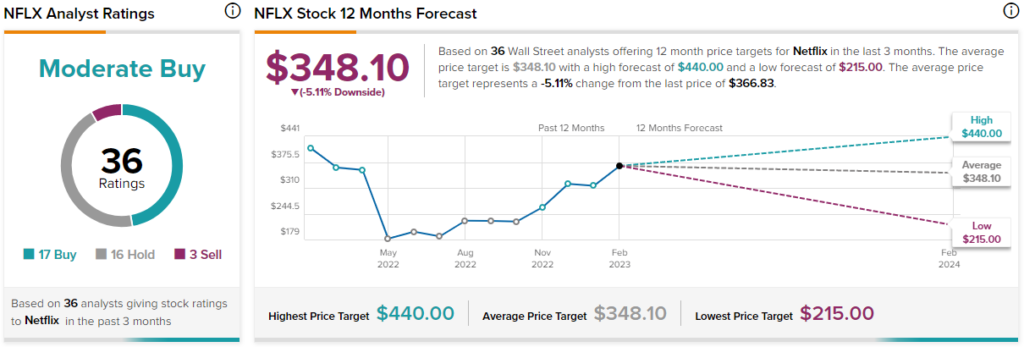Netflix, Inc. (NASDAQ:NFLX), the most popular streaming service in the world, has often come under pressure for its lack of focus on profitability. Since its early days, the company has unwaveringly focused on revenue growth and penetrating as many households as possible. This strategy has enabled Netflix to become the undisputed leader of the global content streaming industry, and the company is now focusing on maximizing its profits.
Don't Miss our Black Friday Offers:
- Unlock your investing potential with TipRanks Premium - Now At 40% OFF!
- Make smarter investments with weekly expert stock picks from the Smart Investor Newsletter
On February 1, Netflix updated its Help Center to include new limitations on password sharing and later went on to elaborate that these limitations are only applicable to Chile, Costa Rica, and Peru for the time being.
This decision did not receive a warm welcome from many social media users, but the company seems to be laser-focused on improving the monetization of its content and users. Despite the increasing competition in the industry, I am bullish on the prospects for Netflix.

Revenue-Boosting Initiatives
It is common practice for Netflix users to share their account passwords with friends and family, which is proving to be costly for the company. According to Netflix, more than 100 million households access Netflix without paying for the services, using the accounts of their loved ones.
Last April, Netflix claimed that password sharing was one of the major reasons behind lackluster subscriber growth in the recent past. To capture additional revenue from this cohort of users, Netflix is likely to charge a few dollars from every user to enable password sharing across family members. This strategy is likely to boost revenue while enabling password-sharing users to enjoy the most of Netflix without having to pay the full price.
Another revenue-boosting strategy is the lower-priced, ad-supported tier. Last November, Netflix unveiled a new subscription tier in the U.S. for $6.99 per month, offering the same TV shows and movies at a discounted price but with commercials. The new tier is available in 12 countries today, including the U.S., UK, France, and Japan. This new subscription tier will help Netflix attract cost-conscious users who were previously using pirated content.
In addition to attracting new users, the ad-supported tier will help Netflix diversify its revenue stream with advertising revenue. Although average revenue per user will take a hit with the rollout of the ad-supported tier, this negative impact will likely be offset by incremental ad revenue in the long run. Insider Intelligence projects Netflix ad revenue to surpass $1 billion in 2024, supported by the higher cost per mille (CPM) the platform can charge advertisers because of the highly-personalized data collected by the company that enables marketers to run targeted ad campaigns.
Netflix is changing its stance on theatrical releases of hit movies as well, and this could be an early sign of its intentions to distribute high-budget movies in theatres. If done successfully, this can open the doors for Netflix to bring additional revenue.
For instance, last year, Netflix released Glass Onion: A Knives Out Mystery starring Daniel Craig, in 600 movie theatres in the United States for seven days before making the movie available for subscribers. This could be the beginning of a new journey for Netflix as a blockbuster movie producer that appeals to the masses.
Short-Term Losses Could Lead to Long-Term Gains
Netflix’s aggressive international expansion is likely to hurt operating margins in the short term as the company continues to produce local-language original content in Europe, Latin America, India, Korea, and Japan to attract new users in these regions.
Higher spending on content is unlikely to be rewarded handsomely in the short term as the number of subscribers will need to eclipse a certain threshold for unit economics to kick in. However, the addition of subscribers will set the platform for Netflix to grow in the long run as the monetizable user base grows.
Is Netflix a Buy, According to Wall Street Analysts?
Netflix stock has risen more than 24% since the beginning of the year, and this stellar run has forced some analysts to be wary of future investment returns. For instance, PhillipCapital analyst Jonathan Woo downgraded his rating on the company on January 26 despite boosting his price target to $388 from $346.
On the contrary, Jefferies analyst Andrew Uerkwitz remains bullish on the prospects for Netflix as his findings indicate robust retention rates in the next couple of years, even after considering the possibility of password-sharing users canceling the service. The analyst raised the price target for Netflix from $400 to $425 on February 6.
Overall, based on the ratings of 36 Wall Street analysts, the average Netflix price target is $348.10, which implies the stock is overvalued by around 5.1% today.

The Takeaway
Netflix has a renewed focus on profitability, which is encouraging news for long-term shareholders. The company is expected to roll out several new strategies to monetize its existing user base while attracting new users globally. Even on the back of a strong start to 2023, Netflix still seems an attractive bet for long-term-oriented growth investors.



















